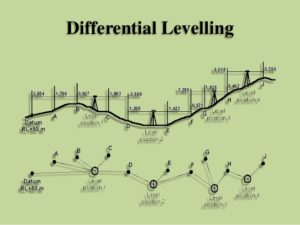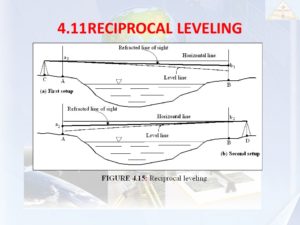
Levelling is the measurement of geodetic height using an optical levelling instrument and a level staff or rod having a numbered scale. Common levelling instruments include the spirit level, the dumpy level, the digital level, and the laser level.
Classification of Levelling
- Simple of Levelling
- Differential Levelling
- Fly Levelling
- Check Levelling
- Profile Levelling
- Cross Levelling
- Reciprocal Levelling
- Precise Levelling
- Trigonometric Levelling
- Barometric Levelling
- Hypersometric Levelling
Simple Levelling
- It is the simplest method used, when it is required to find the difference in elevation between 2 points.

Differential Levelling
- This method is used to find the difference in the elevation between points if they are too far apart or the difference in elevation between them is too much.

Fly Levelling
- Fly leveling is just like differential leveling carried out to check the accuracy of leveling work. In fly leveling only B.S. and F.S. are taken.

Check Levelling
- This kind of leveling is carried out to check the accuracy of work. It is done at the end of the days work in the form of Fly Levelling to connect the finishing point and starting point.

Profile Levelling or L-Section
- This method is used for taking levels along the centre line of any alignment like road, railway canal, etc. The object is to determine the undulations of the ground surface along the alignment.

Cross Levelling
- This operation is carried out perpendicular to alignment at an interval of 10,20,30,40m. The idea is to make an estimate of earthwork.

Reciprocal Levelling
- This method is adopted to accurately determine the difference of level between two points which are far apart. It is also used when it is not possible to setup level in midway between two points.
- Let A and B be the two points on opposite banks of a river. It is required to find out the level difference between A&B.
- Setup the level very near to A and take the reading at A and B let the reading be a1 and b1.
- Shift the level and setup very near to B and observe A and B to get reading a2 and b
Let d is the true difference of level between A and B, and e=error due to curvature, refraction and imperfect adjustment.

Precise evelling
- It is used for establishing bench marks for future public use. It is carried out with high degree of accuracy using advanced instruments.

Trigonometric Levelling
- In this method vertical distances between points are computed by observing horizontal distances and vertical angle between points.

Barometric Levelling
- In this method the altitude difference is determined by means of a barometer.
- Barometer Leveling is based on the fact that the atmospheric pressure varies inversely with height. In this method a barometer is used to determine the differences in elevation of points, which differ considerably in heights as in a hilly area or mountainous country.

Hypsometric Levelling
- The working of Hypsometry for determining the elevation depends upon the fact that the temperature at which water boils varies with the atmospheric pressure. The boiling point of water reduces at higher altitude thus knowing the boiling point of water, the atmospheric pressure can be calculated and knowing the atmospheric pressure altitude or elevation can be determined.
Refraction
- The ray of light pass through layers of air of different densities and refractor bent down. The effect of refraction is to make the object appear higher then they really are. Refraction varies considerably with climate conditions.
However it is taken as,
- Cr=0.0112D2m(+)
- Refraction is always additive.
- True staff reading
- =Observed staff Reading + Refraction correction.
Method of Reducing Levels
- Height of Instrument Method
- This method consist of finding H.I. for every setup of instrument, and then obtaining the R.L. of point of reference with respect to H.I.
Curvature Correction
- For long sight the curvature of earth can effect staff readings. The line of sight is horizontal but the level line is curved and parallel to the mean apheroidal surface of the earth.
- The vertical distance between the line of sight and level line at particular place is called the curvature correction.
- The effect of curvature is to cause the object sighted to appear lower than they really are.
- Curvature correction is always Subtractive(-).
- True staff reading = (Observed staff reading-0.0785D2)m.
Where D=distance in KM.
Common errors in Leveling: The following are the different sources of Errors-
- Foresight and back sight not being taken on exactly the same point.
- Reading the staff upward instead of downward
- Reading of stadia hair.
- Reading of wrong number of meter and decimeter.
- Entering back sight in F.S. and vice versa.
- Transposing the figures.
- Omitting an entry.
- The leveling staff not being fully extended.
- The Curvature of the Earth may affect the staff readings when the distance of sight is long.
- The effect of refraction may cause a wrong staaf reading.
- There are some errors in staff readings due to high velocity wind.
Personal Error
- The Instrument may not be leveled.
- The focusing of eye piece and objective glass may not be perfect.
- The parallax may not be eliminated.
- The position of staff may have changed.
- Entry and recording in the field book may not be correct.
- The staff may not be fully extended, may not be held vertical.
Instrumental Error
- The Permanent adjustment of the instrument may not be perfect. That is the line of collimation may not be horizontal line.
- The internal arrangement of focusing tube may not be correct.
- The graduation of the staff may not be perfect.
- Defective bubble tube, if the bubble tube is sluggish, it may apparently be in the mid-position even though the bubble line is not horizontal.


